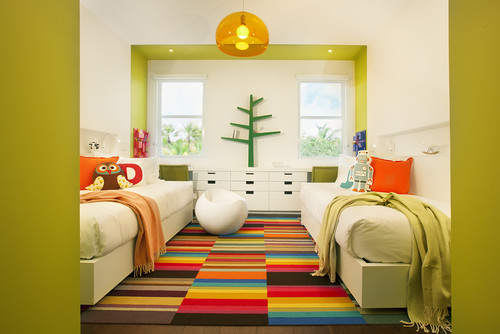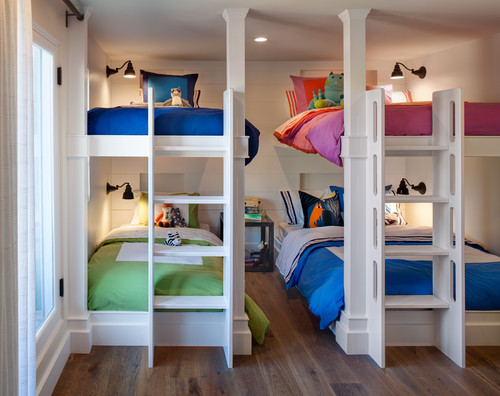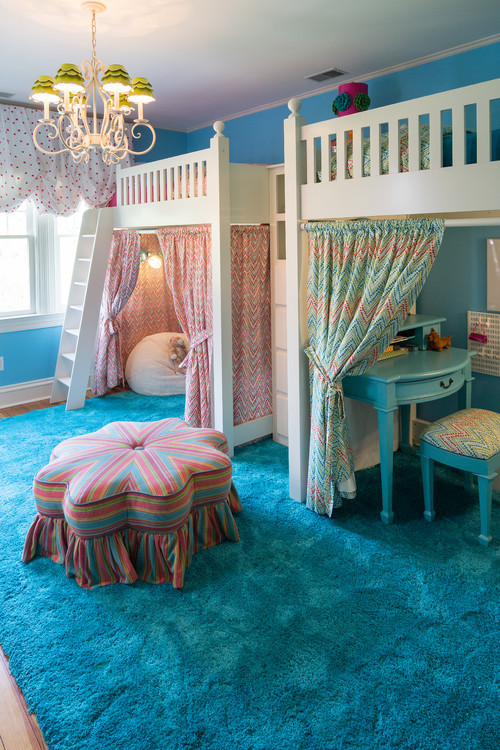Not everyone has the luxury of having their own bedroom, especially children.
Decorating a shared bedroom for a girl and boy presents a unique challenge, but can be done sucessfully with careful planning.
Here are some practical tips & creative ideas for designing a shared room for a boy and a girl.
 Skip the Pink and Blue
Skip the Pink and Blue
When selecting shared items for the room, such as the wall color, avoid stereotypical girl and boy colors such as baby pink, lavender, and baby blue.
Instead, decorate with gender neutral colors so the room does not look like a girl room or a boy room.
Choose a gender neutral color scheme that appeals to both your girl and your boy.
Suggested colors include most any neutral like white, beige, gray, brown, and black.
You can also use red, orange, and green or more complex colors like mustard, sage, turquoise, teal, and terracotta.
Identical Furniture
Use identical gender neutral furniture when decorating a shared boy and girl bedroom.
The identical furniture will create cohesion in a shared room.
Same Style, Different Colors
If using fabric, such as a comforter or rug, consider using the same pattern for the fabrics but one in girl colors and the other in boy colors.
You can also select a multicolored item, such as a pillow or blanket, for both beds but have the sheets and/or comforter in a girl or boy color that is represented in the multicolored item.
Give each child their own sense of identity with personalized bedding that reflects their interests and personality.
Choose bedding sets in colors or patterns that complement the overall color scheme of the room while allowing each child to express their individual style.
Consider adding decorative pillows or throws in coordinating colors to tie the look together.
Kid Approved Colors
If your children are old enough, let them decided together on colors they both like (and both dislike) for their shared bedroom.
You do not want the room to be so gender neutral that it is boring and sterile.
Perhaps you can present the children with a few adult-approved colors to choose from so you don't accidentally have the children fall in love with a color that you do not want in the home.
Don't Share Everything
If the kids have to share a room, consider getting them each their own things.
They should each have a lamp, not have to share one.
Also consider personalizing each side of the room for each child.
They should have their own space, even if they share a room.
You can add a large photo of each child over their bed, or perhaps their name in decorative letters.
Divide If Possible
Maximize space and functionality by carefully planning the layout of the room.
Consider spitting the room into distinct zones for sleeping, studying, and play to accommodate the needs of both children.
Use furniture such as bunk beds to save floor space and create designated areas for each child's belongings.
If possible create some type of divider between the two sleeping spaces for privacy.
You could use a curtain, a bookcase, or another piece of furniture to split the room.
Adding blackout curtains around each bed will allow one child to be awake and the other asleep.
Maximize Storage
Two people in one bedroom means twice the stuff.
Try to maximize storage wherever possible.
Purchase multi-functional furniture such as beds with built-in drawers to maximize the space.
Use baskets, bins, or storage ottomans to contain all of their toys, books, and clothing.
You can use floor to ceiling shelves.
Bunk beds are also a great option.
There are even loft bunk beds with a desk and dresser underneath and the sleeping area is on top.
Purge
The best way to sucessfully share a room is to purge as many things as possible, especially if your kids used to have their own room but are now having to share.
Kids outgrow clothing, toys, and change their interests so quickly when they are young.
Purge their items before moving into their new room and set a schedule to purge on a regular basis to keep the room looking clean and clutter free.







